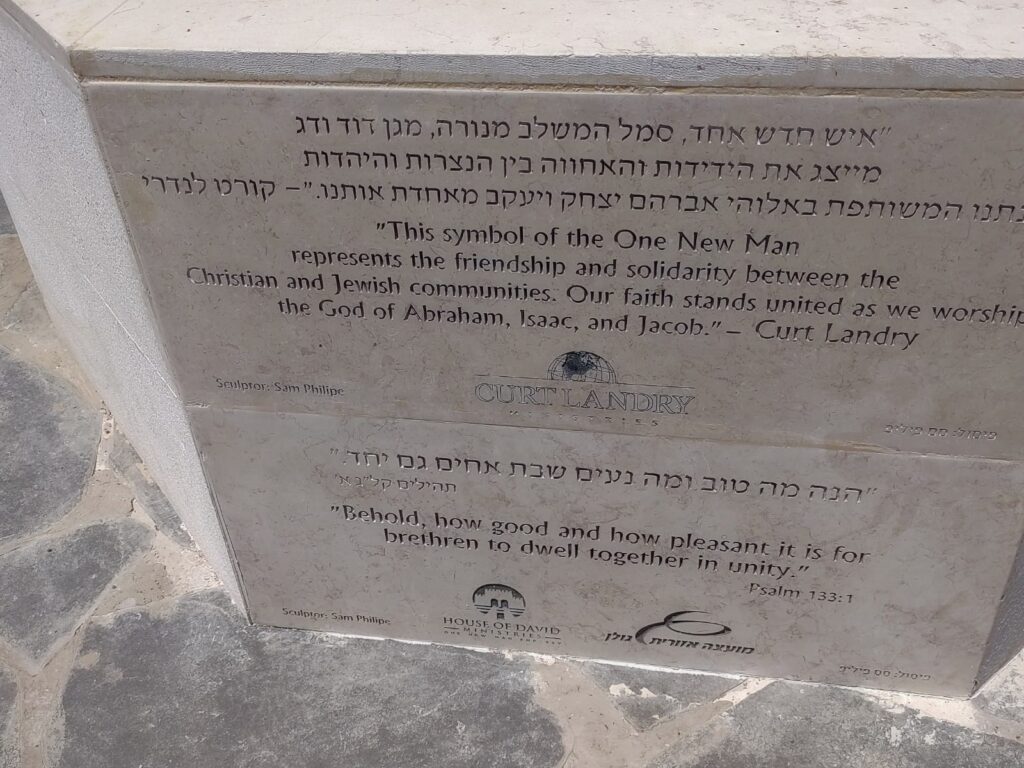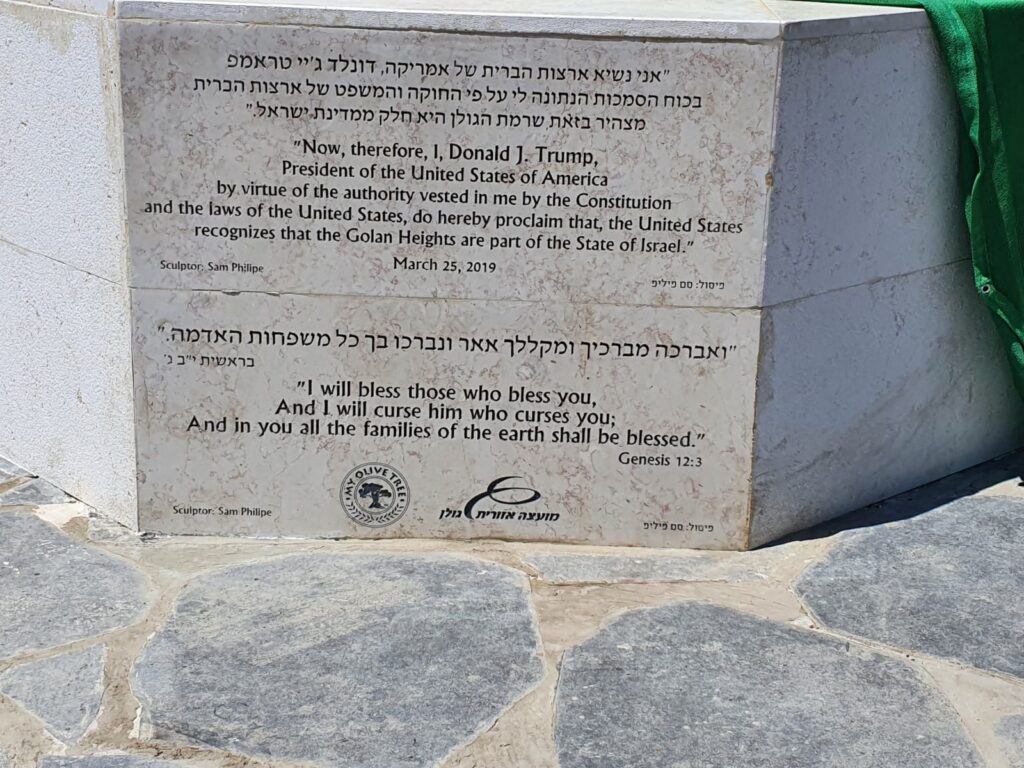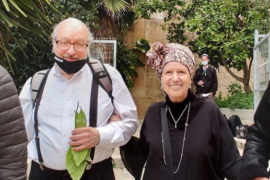A few weeks ago, I hosted some friends in my home who had just returned from touring Israel’s Golan Heights.
Their tour guide mentioned something about a sighting of a bizarre messianic Christian monument at Ein Keshatot.
Located in the Southern Golan, Ein Keshatot is an impressive national heritage site featuring a restored Jewish village from the period of the Mishna, complete with arches, running springs, and a stunning reconstructed 1,500-year-old synagogue.
When I asked tour guide Seth Vogelman of Maale Adumim to elaborate on what he had seen, he told me that he was surprised to come across a very large and conspicuous Christian/Messianic symbol, with obvious theological implications, at an Israeli national heritage site. He felt such a sculpture in that location is “highly inappropriate” and went on to explain that the “One New Man” monument has nothing to do with the historic site of Ein Keshatot and its ancient synagogue, and that he planned on giving a heads-up to the many tour guides who will be bringing visitors to the area. I imagine he did. Another respected tour guide who recently led a large group to the Golan responded to a mutual friend, “this is horrifying!”
Twenty-four hours later, an acquaintance who works in Israel advocacy sent me an image that he happened upon in the “Week in Photos” page of the Jerusalem Post Magazine. The darkish silhouette of a crane lifting what appeared to be a sizable messianic symbol, appeared with a caption identifying the location as Ein Keshatot. The photographer, Harry Tropp, was kind enough to send me the high-resolution image that he took on June 15 while on a group tour in the Golan.
Tropp said that he did not recognize the Christian symbolism at the time because he had no idea that the bottom section was a fish. From his vantage point, he thought it was an arch.

The following morning, a funny thing happened on the way to the chocolate factory in Ein Ziwan. A friend and I took a detour to Ein Keshatot and lo and behold, a short distance from the entrance we saw in the clearing an imposing and clearly recognizable symbol of the messianic Christian or “One New Man” missionary movement.
If that wasn’t unsettling enough, bells went off in my head when I read the inscription on the statue’s base. Curt Landry and his House of David Ministries collaborated with the Golan Regional Council on this project.
I’m familiar with sometimes “Pastor” sometimes “Rabbi” but always missionary Curt Landry and his evangelical House of David Ministries. Purportedly born to a Jewish mother, Landry found Jesus and became inspired by the hybrid “One New Man” message of Jew and Christian being theologically grafted together through Jesus.
To the uninitiated, the inscription itself would seem benign: “This symbol of the One New Man represents the friendship and brotherhood between Christianity and Judaism. Our shared love for the God of Abraham, Isaac and Jacob.” -Curt Landry
But to better understand, one need only to listen to Landry holding forth on Prophetic TV – as a “Jew”- of the blindness of the Jews, and to note the condescending tone as he talks about Jewish separateness and circumcision.
Landry has no problem usurping Jewish ritual objects such as the shofar, menora and tallit because they and Jewish roots, according to Landry, never really belonged to the Jews in the first place. It seems that “through a multitude of bad choices,” God chose to give those things to the “stiff-necks.” That is until Jesus came along…
Landry’s webpages make the meaning of “One New Man” and the messianic symbol very clear, and it does not bode well for the future of Israel and the Jewish people:
- “The mission of The One New Man Network is to be a bridge of unity and restoration between Israel and the Church.”
- “The Bible says that Gentile Believers in Jesus (or Yeshua in Hebrew), are grafted into the commonwealth of Israel (Romans 11: 17, Ephesians 2:12). Because of God’s divine mercy, Gentile Believers are no longer strangers to the covenant promises God established with Israel.”
- “The Messianic Seal depicts the divine family of God. It is a beautiful emblem of God’s vision for Jews and Gentiles to come together, being reconciled through Yeshua. It depicts your identity and inheritance as a Believer.”
As far as Jews are concerned, “One New Man” is nothing more than another name for One New Replacement Theology that eschatologically aspires to erase Jewishness and the Jewish people. I suppose some will laugh and dismiss this all as an evangelical end-times pipe dream, except that Landry is doing his darndest to actualize his ambitions via connections with Israeli leaders and a vast number of projects on the ground.
The Other Side
The other side of the engraved base of the monument is a horse of a different color that jumps from the theological to the political. Former US President Donald Trump’s proclamation recognizing the Golan Heights as part of Israel is intertwined with another Landry project – “My Olive Tree” – and the Golan Regional Council is once again in collaboration. It doesn’t make me feel better to see that Genesis (B’reishit) 12:3 is thrown in for good measure.

It seems that Landry has a vested interest in Trump Heights, a new town in the Golan honoring the former US president. The “My Olive Tree” project aspires to plant 500 olive trees in the “Trump Grove” adjacent to Trump Heights and eventually 1 million olive trees throughout Israel – including a special project underway in Jerusalem’s Kidron Valley: “When King Jesus Returns, He Will Pass through the Ancient Kidron Valley and Reenter the Holy Gates of Jerusalem as King of Kings… And Now You Can Plant the Garden That Will Make Way for Jesus’ Triumphant Return!”
The “My Olive Tree” website prominently features endorsements from the Israeli Ministry of Agriculture, the Israeli Olive Oil Council, the Israel Defense Forces, and the City of Jerusalem.
The question that begs to be asked is why are Israeli government institutions playing into and entertaining Landry’s eschatological fantasies? And where does the Israel Parks Authority fit in to all this?
Having had enough for the day, I returned home and consulted with friends and colleagues who have spent many torturous years warning the Israeli public and Diaspora Jews about the complexities and potential pitfalls when partnering with evangelical groups.
It’s vacation time in Israel and the few serious investigative journalists we contacted – who work for major publications and frequently dare to be critical of Israel’s “best friends” – did express interest in the story but would not be able to address it until after their return from summer break. So we decided to generate interest on social media by posting the photos and calling for an investigation.
We also contacted friends, professionals, relatives, rabbis, and concerned citizens of the Golan Heights. We were pleased and surprised at the immediate and intense interest and response. The Golan Regional Council began to feel pressure and to hear protests from their own residents.
A day later, after seeing the images of the monument on Facebook, I was contacted by a representative from the Or L’Achim anti-missionary group and a by journalist from Israel National News (Arutz 7). They requested permission to use the photos.
Art with No Red Lines – Save for the Cross
After viewing a short video about artist Sam Philipe’s messianic sculpture at Ein Keshatot, as well as his sculpture at the entrance to Trump Heights, I was uncomfortable with a portion of the written narrative:
“A Menorah was found on the walls of the 1500-year-old Ein Kshatot Synagogue. The artist Sam Philipe recreated the menorah accordingly. He attached the star of David and the fish…”
I’m an artist too, with a vivid imagination, and visions of the Arch of Titus came dancing through my head. An artist gets inspired by the Jewish symbol of the menora found at an ancient synagogue, captures the image, converts it into a Christian missionary symbol and places it in the same national heritage site as the synagogue to illustrate “the common roots between Jews and Christians.” It was very disconcerting.
I left a message about the piece at Ein Keshatot with sculptor Sam Philipe who, to his credit, promptly called me back. Now Sam Philipe is no slouch. He is an extremely prolific and gifted artist who has presented his work to presidents, popes, and kings, not to mention Shalva, the IDF and countless organizations and municipalities throughout Israel. He specializes in Jewish and Christian biblical themes that he exhibits at his impressive gallery near Jerusalem’s outdoor Mamilla shopping center.
When I asked Mr. Philipe if he was aware of the theological meaning behind his sculpture, he replied affirmatively but suggested that I forget the symbolism and see the piece as an artistic blend of three aesthetic objects.
Philipe informed me that he knew the person who first discovered the symbol before it was adopted as the messianic emblem. He identified that individual as “Doron Schneider’s father” and said that it was considered to represent the “New Christian.”
I let Philipe know that I’m familiar with Doron Schneider. He worked for many years as the liaison officer and director of public relations for the International Christian Embassy in Jerusalem and identifies as “a convinced Jesus believing Jew.”
I also mentioned to the artist that I understand that he has worked in a senior capacity with Curt Landry Ministries for several years. He denied that and suggested that I shouldn’t believe everything I read in the media. However, Sam Philipe frequently appears in Landry’s interviews and video clips, and this is what appears on Curt Landry’s Ministries website as of August 2019:
“Sam has been working on Curt Landry Ministries projects since 2011. He has grown into the position of the general on-site overseer of all Israeli projects within the ministry. His role is not small. Some of the duties Sam is tasked with include… Visiting our outreach projects and distributing aid Maintaining relationships in Israel, including government relationships and new opportunities for IDF veterans Capturing videos, photographs, and stories of those who receive your support. Meeting with us and providing updates throughout the month. Essentially, Sam is responsible for making sure our donors’ support is used as effectively as possible for the Kingdom.”
What Philipe did confirm is that it was he who approached the heads of the Golan Regional Council and proposed the sculpture project for Ein Keshatot.
When I asked about the vast area that had been cleared around the statue, Philipe said it is planned to serve as a parking lot and the sculpture is part of a plan to draw Christian tourism, as the ancient synagogue and village may not be enough to bring in large numbers of Christian visitors.
I asked Philipe if he didn’t see a conflict or direct challenge to a Jewish national heritage site. Visitors would be pulling into a parking area that features a Christian messianic monument overlooking a stunning view of the Kineret when the site is intended to direct and draw people to a magnificent 1,500-year-old synagogue and Talmudic village.
Sam Philipe is non-confrontational. He remained polite and soft-spoken throughout our almost 30 minute conversation. That personality, combined with his reputation, may have served him and Curt Landry well when presenting the monument plan to the Golan Council. In my eyes, Philipe remains an extremely talented craftsman who can’t seem to draw lines in the color red – except for one. He said he would never put a cross in the location, as that would offend sensibilities.
Case of the Missing Missionary
With Golan residents beginning to see the fruits of their pro-activity with literal curtains coming down on the monument, INN ran a report on July 25 with the headline, “After intervention by INN: Monument with symbols of Messianic Judaism to be removed”
It’s natural to want credit, especially when they may deserve a piece of it. But there was a glaring and problematic omission in their report that read, “The person who donated the monument is Pastor Curt Landry, known for his many donations to Israel.”
The total lack of interest in Landry as a missionary personality, who frequently poses as a rabbi and pushes a theologically loaded agenda directed at the Jewish people, was somewhat surprising. Statues don’t create themselves out of thin air – unless one believes in idolatry or spontaneous generation. There’s a person with a mission behind the monument, and it’s hard to figure out why certain media outlets portrayed an inanimate sculpture as the problem, as if it has a life of its own.
Unfortunately, this monument does not have clay feet. The sculpture is set on a substantial engraved concrete base and while the sculpture may be removed the collaboration between the Golan Regional Council and a missionary set on distorting and destroying our identity as we know it remains set in stone unless someone has the good sense to remove the base too. It’s quite possible that a kinder, gentler, albeit Christian symbol may be placed upon that pedestal unless this is prevented through appropriate and vigorous protest.
The only people who may find themselves frozen and unable to move against the missionaries are those who accept funds from evangelizing ministries and say “no” when called upon to defend their identity, heritage and people. Those organizational and government leaders who appear in videos and testimonies praising Landry are responsible for empowering and emboldening evangelical designs on the Jewish state.
That Curt Landry Ministries is actively “sharing the good news” (proselytizing) via his book distributed (by his account) to tens of thousands of IDF soldiers who are “Hungry for Truth” about “One New Man” should serve as a startling wake-up call for any Jewish organization that is “benefitting” from any of Landry’s projects.
That Landry makes the following claim should send a humiliating distress signal to the IDF:
“Because of the unfavorable images that several organizations have portrayed of the people, former Chief of Staff Eisenkot created restrictions for giving. He stated that no longer would organizations be able to “give gifts” to IDF soldiers, EXCEPT Curt Landry Ministries.”

That Israel’s Holocaust survivors, young adults in foster care, those in rehab centers, children, lone soldiers and victims of prostitution and sex trafficking are all being shown the love of Jesus and are an integral part of Landry’s missionary campaigns and promotions should cause every Jew to cringe.
By protecting or failing to deliver transparent reporting on Israel’s “Christian Zionist friends” like Landry, Israel’s national religious media is causing untold damage to Am Yisrael.
Anyone who feels anxious about cracking down on missionary activity lest evangelical leadership accuse us of denying religious freedom, church persecution, xenophobia, needless fear of the marketplace of ideas, or any other Western “Judeo-Christian” innovation, should do a reality check, and remember who they are and where they are standing as Jews in their homeland.
Responsible and Telling Report
Atara Beck, managing editor of World Israel News, also questioned some of the limited reporting on the statue episode and published a more comprehensive piece on July 27 that asked the right questions. Some of the answers she received from the Golan Council spokesperson were wanting.
Golan Council spokesperson Limor Holtz remarked that, “it was not the Golan residents who were bothered by it [the statue].” She went on to say that “We didn’t know until a few days ago that somebody got offended by it.”
A significant number of Golan citizens are alarmed by the presence of this statue and have taken their complaints directly to the heads of the Golan Council and continue to closely monitor the situation. Hundreds of comments and criticisms appear on Golan social media forums. It wasn’t “someone” who was offended.
Holtz told Beck about efforts involving the donor and artist to find “a new location that everybody is going to be happy about.” Given the circumstances, I’m not sure that such a “happy” alternative can be found in this country.
I believe this kind of “damage control” is a disservice to the people of the Golan Heights. What the intensity of concern and flurry of activity proves is that the citizens of the Golan are no less committed to maintaining the integrity of their faith, heritage, people and land than the journalists in Jerusalem and anti-assimilation groups in Bnei Brak.
Thankfully, it seems that the good people of the Golan Regional Council recognize that a mistake had been made and, as of this writing, a written apology and assurances have been received that the now wrapped-up messianic missionary monument will be removed from our national heritage site.






Thank you for this expose…well-written, direct, factual. We can only hope that our leaders can take action on these religious predators. Israeli passivity and lack of action about active missionaries and missionizing in Israel is our own “virus” that we need to inoculate against.